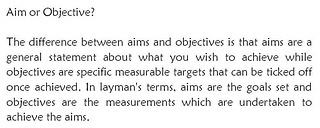Objectives are among the most important things to have as a teacher. They act as a guide for both you and your learners and without them, you will both be lost!
Not only do they enable you to focus your teaching on a specific goal, they also help your students understand why they are learning. What’s more, clearly written objectives let you decide how to assess learning, because they necessitate that learners demonstrate what they have learned. If you have unambiguous teaching objectives, you will make more productive use of your time in class. These are the three steps that I use and recommend you follow, too.
Clarification: Is it an aim or an objective?

Step one: think
Ok, before you read any further, let’s make it clear I’m talking about objectives today and not aims!
Carefully consider your institution’s curriculum
Generally speaking, your objectives should always relate to your curriculum. If not, it will be hard to justify why you are doing this, both to learners and to your superiors. Exceptions might be, for example, when you have to review and give extra practice in a particular language point to a class that has just moved up a level and need it.
How are you going to base your objective on your curriculum? First and foremost, you need to review the material you will be teaching to see how you can relate it to the curriculum. Often you’ll find that the material has been chosen with the curriculum in mind, so half of the job has already been done for you. The best place to find ‘inspiration’ is in the teacher’s book of whichever material you are using, as these usually tell you exactly why the materials have been designed and with what purpose in mind.
Break the work down into small steps
If what you think you want to do is ‘Compare the use of the simple past and present perfect with adverbial time phrases,’ then your learners will first have to be able to know about those tenses and the associated time phrases. This may involve teaching them about the form of the tenses, their auxiliary verbs, the second and third forms of the verb and also the type of adverbial time phrases used with each. Fortunately, your textbook is probably following a linear progression of grammar points, and so already does this. If you feel that your course materials don’t break it down enough, you can always turn to supplemental materials.
Step two: take action
‘Learners will be able to . . .’
What will they be able to do? I think this phrase is a must at the beginning of any objective. Your objective is aimed at ‘permitting’ learners to express what they know, and therefore should be a reflection of this.
Use verbs that express actions, not feelings
Bloom’s taxonomy works well as a list of verbs for describing the many ways in which learners can demonstrate knowledge. Consider these examples of what I mean by action verbs: ‘analyze,’ ‘compare’ ‘list,’ and ‘evaluate.’ Decide what type of action you want learners to be able to do and describe it accordingly. Try and avoid wishy-washy verbs like ‘understand’ because, let’s face it, this is hard to measure in an objective.
List everything in simple steps
Ok, so now we have the ‘learners will be able to…’ followed by an action verb. We need to finish the sentence with specific, simple language that explains everything your learners will do. Remember, you should make this simple enough that your learners will be able to understand. Rather than “Learners will be able to ascertain certain fundamental subtleties of the present perfect aspect,” try “Learners will be able to identify the differences between the use ‘for’ and ‘since’ with the present perfect aspect.”
Step three: in class
This is easy to forget but it really is the whole point of the task: share your objective with your learners! The act of physically writing your objective on the board will let your learners know what you expect them to learn. They will appreciate this as much as you.

